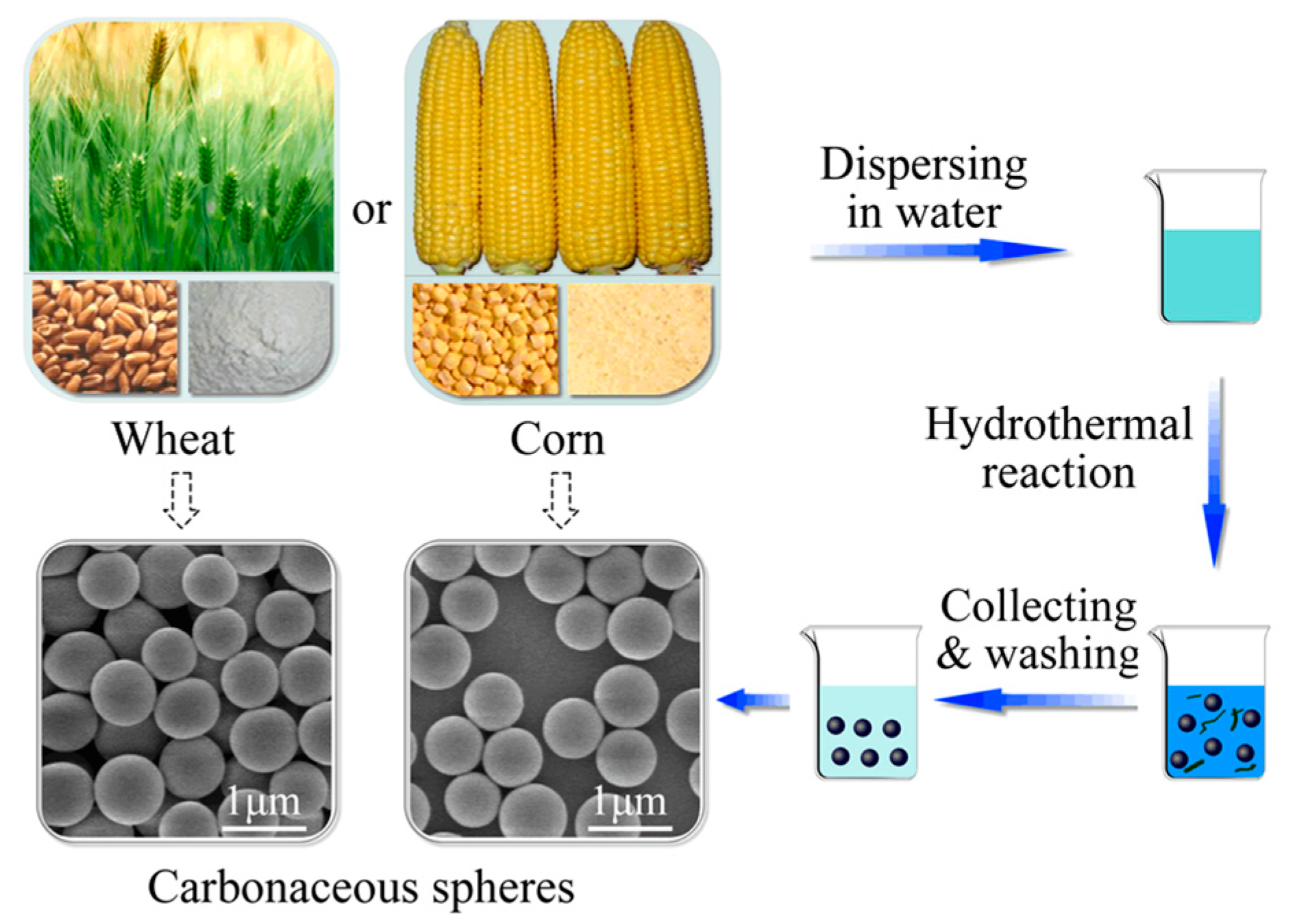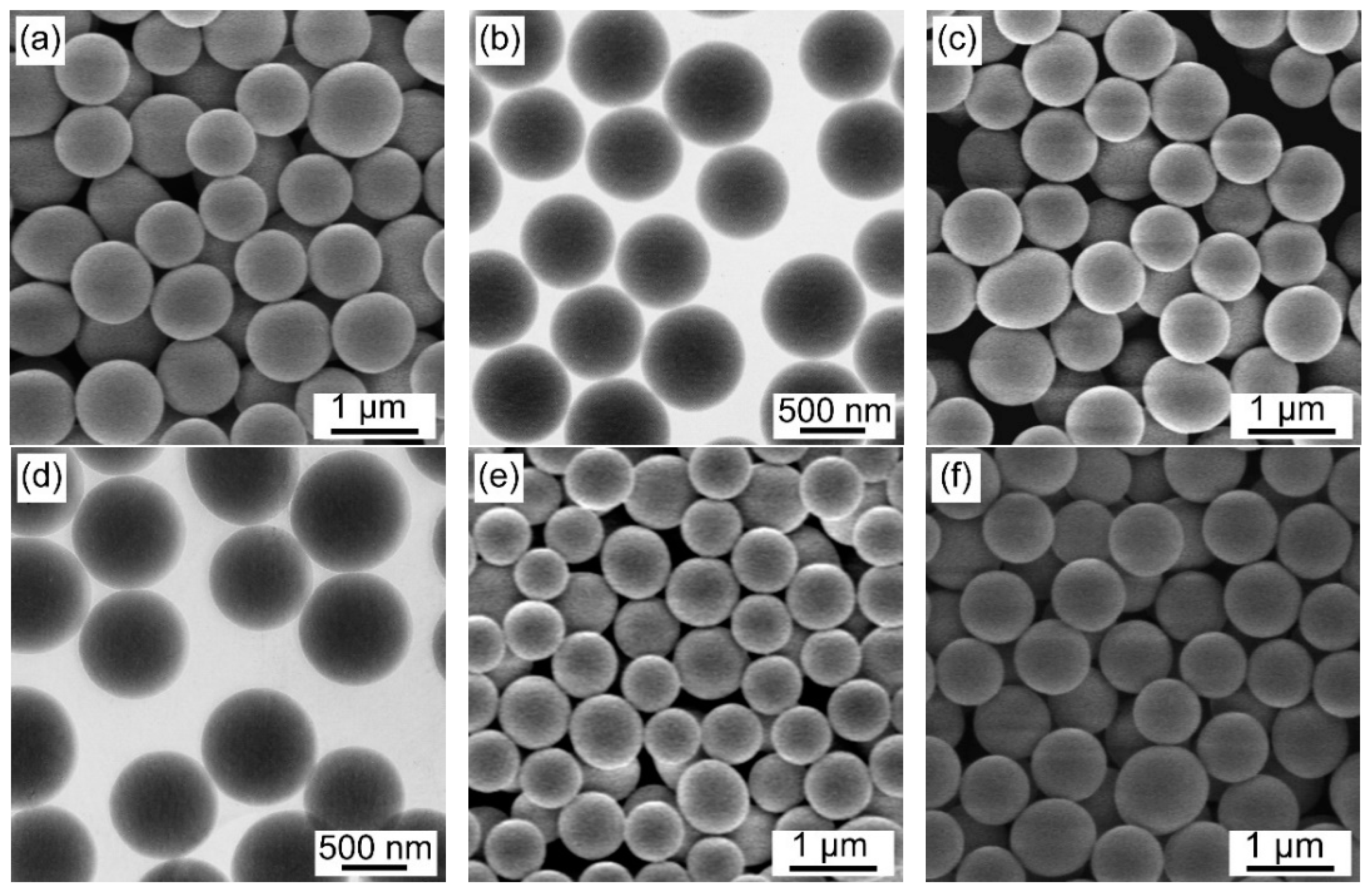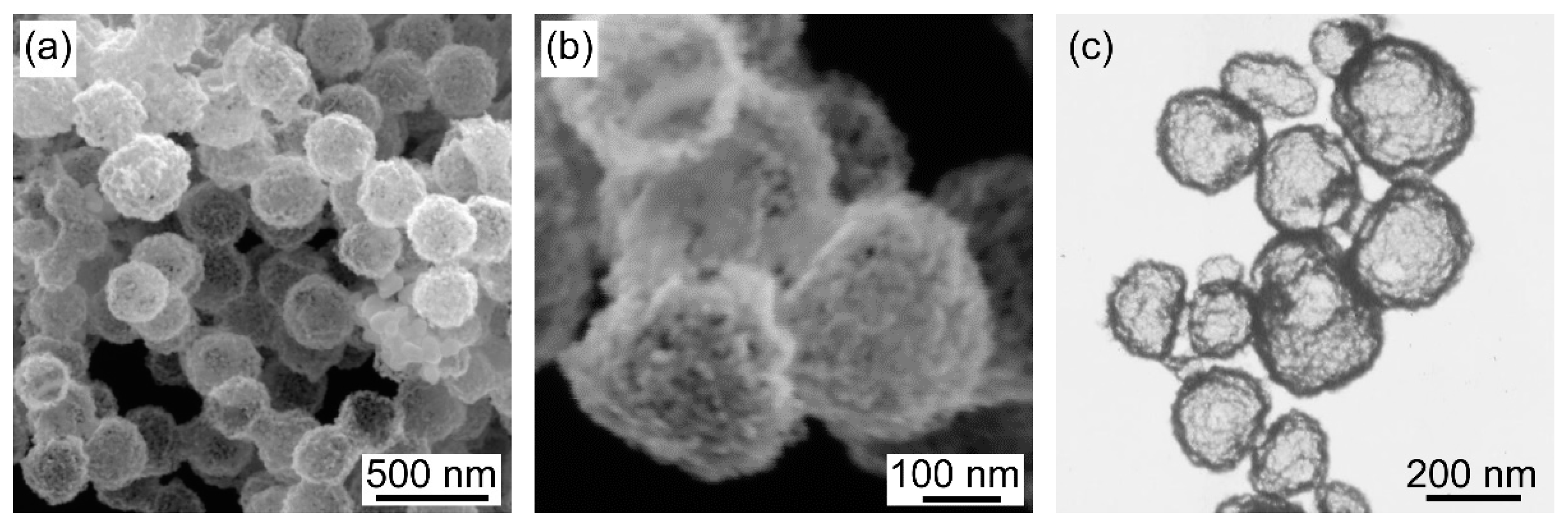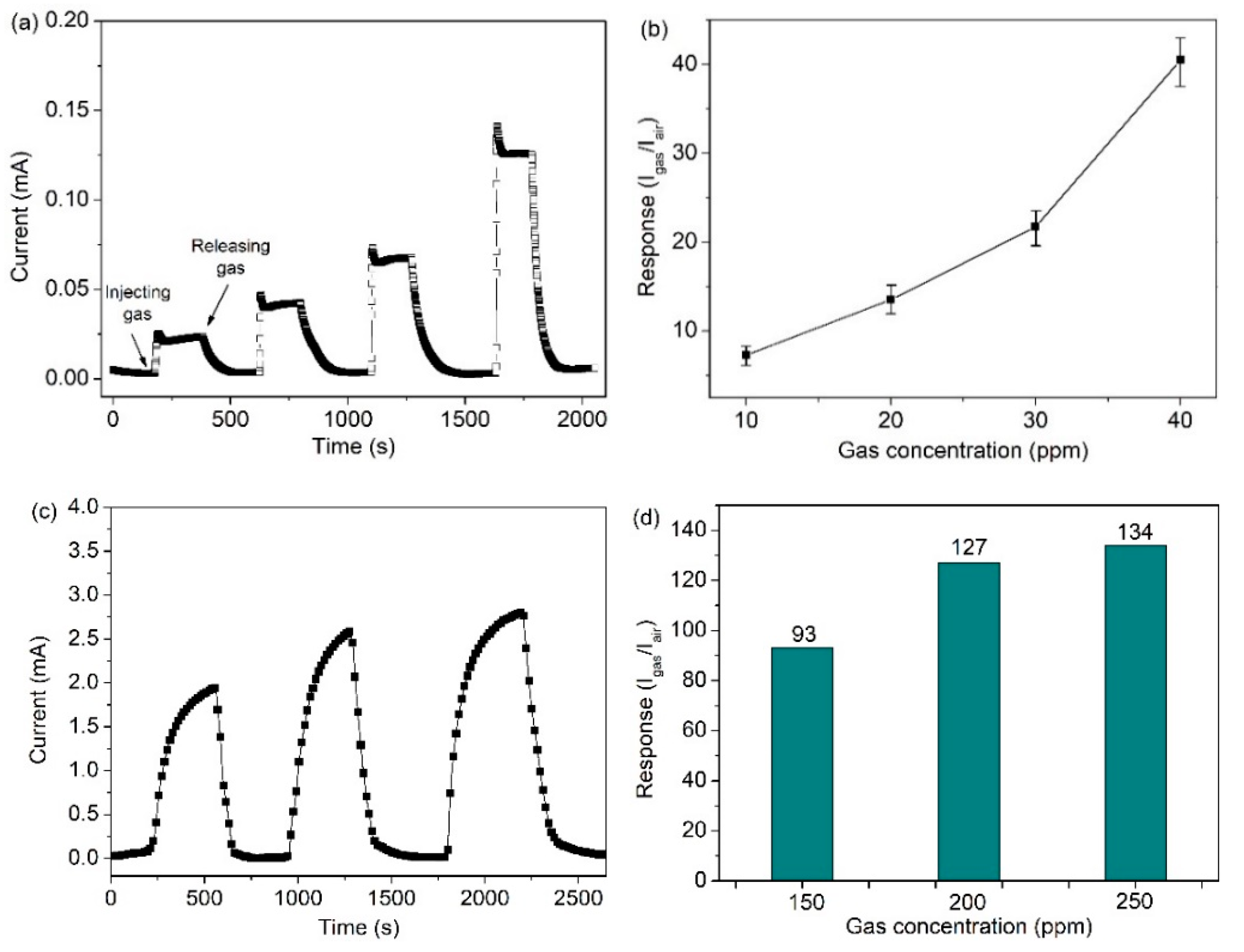Environmentally Friendly and Cost-Effective Synthesis of Carbonaceous Particles for Preparing Hollow SnO2 Nanospheres and their Bifunctional Li-Storage and Gas-Sensing Properties
Abstract
1. Introduction
2. Experimental
2.1. Reagents and Solutions
2.2. Preparation of the Carbonaceous Particles
2.3. Preparation of the Hollow SnO2 Spheres
2.4. Characterizations
2.5. Energy-Storage Performance Study
2.6. Gas Sensor Fabrication and Gas-Sensing Property Measurements
3. Results and Discussion
4. Conclusions
Author Contributions
Funding
Conflicts of Interest
References
- Yang, Z.F.; Tian, J.R.; Yin, Z.F.; Cui, C.J.; Qian, W. Carbon nanotube- and graphene-based nanomaterials and applications in high-voltage supercapacitor: A review. Carbon 2019, 141, 467–480. [Google Scholar] [CrossRef]
- He, Y.; Zhao, L.D.; Wang, X.J.; Liu, L.Y.; Liu, H. Microstructured hybrid nanocomposite flexible piezoresistive sensor and its sensitivity analysis by mechanical finite-element simulation. Nanotechnology 2020, 31, 185502. [Google Scholar] [CrossRef] [PubMed]
- Kim, T.; Cho, M.; Yu, K.J. Flexible and stretchable bio-tntegrated electronics based on carbon nanotube and graphene. Materials 2018, 11, 1163. [Google Scholar] [CrossRef]
- He, X.Z. Techno-economic feasibility analysis on carbon membranes for hydrogen purification. Sep. Purif. Techbnol. 2017, 186, 117–124. [Google Scholar] [CrossRef]
- Yan, D.Y.; Hu, H.; Gao, N.Y.; Ye, J.S.; Ou, H.S. Fabrication of carbon nanotube functionalized MIL-101(Fe) for enhanced visible-light photocatalysis of ciprofloxacin in aqueous solution. Appl. Surf. Sci. 2019, 498, 143836. [Google Scholar] [CrossRef]
- Zhang, Y.X.; Cai, T.; Shang, W.J.; Liu, D.; Guo, Q.; Liu, S.G. Facile synthesis of photoluminescent inorganic-organic hybrid carbon dots codoped with B and N: Towards an efficient lubrication additive. Dalton Trans. 2017, 46, 12306–12312. [Google Scholar] [CrossRef]
- Nowak, A.P. Composites of tin oxide and different carbonaceous materials as negative electrodes in lithium-ion batteries. J. Solid State Electrochem. 2018, 22, 2297–2304. [Google Scholar] [CrossRef]
- Xiao, Q.; Wang, K.; Wang, X.X.; Huang, S.P.; Cai, N.N.; Li, N. Solvent-free template synthesis of SnO2/C hybrid hollow spheres for superior lithium-sulfur batteries. Mater. Chem. Phys. 2020, 239, 122070. [Google Scholar] [CrossRef]
- Kang, Y.R.; Li, Z.; Xu, K.; He, X.J.; Wei, S.X.; Cao, Y.M. Hollow SnO2 nanospheres with single-shelled structure and the application for supercapacitors. J. Alloy. Compd. 2019, 779, 728–734. [Google Scholar] [CrossRef]
- Hu, Q.; Huang, B.Y.; Li, Y.; Zhang, S.M.; Zhang, Y.X.; Hua, X.H.; Liu, G.; Li, B.S.; Zhou, J.Y.; Xie, E.Q.; et al. Methanol gas detection of electrospun CeO2 nanofibers by regulating Ce3+/Ce4+ mole ratio via Pd doping. Sens. Actuators B 2020, 307, 127638. [Google Scholar] [CrossRef]
- Liu, H.J.; Zhang, S.; Chen, Y.L.; Zhang, J.T.; Guo, P.; Liu, M.; Lu, X.Q.; Zhang, J.; Wang, Z.J. Rational design of TiO2@nitrogen-doped carbon coaxial nanotubes as anode for advanced lithium ion batteries. Appl. Surf. Sci. 2018, 458, 1018–1025. [Google Scholar] [CrossRef]
- Jin, L.F.; Chen, W.G.; Zhang, H.; Xiao, G.W.; Yu, C.T.; Zhou, Q. Characterization of reduced graphene oxide (rGO)-loaded SnO2 nanocomposite and applications in C2H2 gas detection. Appl. Sci. 2017, 7, 19. [Google Scholar] [CrossRef]
- Hu, L.J.; Qian, Z.X.; Gao, W.; Wang, X.F.; Tian, Y. Nanoengineering of uniform and monodisperse mesoporous carbon nanospheres mediated by long hydrophilic chains of triblock copolymers. J. Mater. Sci. 2020, 55, 2052–2067. [Google Scholar] [CrossRef]
- Zhou, Q.Y.; Chen, W.H.; Jiang, X.; Liu, H.Y.; Ma, S.G.; Wang, B.D. Preparation of a novel nitrogen-containing graphitic mesoporous carbon for the removal of acid red 88. Sci. Rep. 2020, 10, 1353. [Google Scholar] [CrossRef] [PubMed]
- Han, B.; Zhang, E.Y.; Cheng, G.; Zhang, L.J.; Wang, D.W.; Wang, X.K. Hydrothermal carbon superstructures enriched with carboxyl groups for highly efficient uranium removal. Chem. Eng. J. 2018, 338, 734–744. [Google Scholar] [CrossRef]
- Huang, B.B.; Liu, Y.C.; Xie, Z.L. Biomass derived 2D carbons via a hydrothermal carbonization method as efficient bifunctional ORR/HER electrocatalysts. J. Mater. Chem. A 2017, 5, 23481–23488. [Google Scholar] [CrossRef]
- Zhao, T.T.; Zhu, D.L.; Li, W.R.; Li, A.J.; Zhang, J.J. Novel design and synthesis of carbon-coated porous silicon particles as high-performance lithium-ion battery anodes. J. Power Sources 2019, 439, 227027. [Google Scholar] [CrossRef]
- Yang, Q.X.; Wei, L.; Zheng, X.F.; Xiao, L.H. Single particle dynamic imaging and Fe3+ sensing with bright carbon dots derived from bovine serum albumin proteins. Sci. Rep. 2015, 5, 17727. [Google Scholar] [CrossRef]
- Zhang, B.H.; Yang, Q.; Li, Z.H.; Hao, J.C. Green synthesis of luminescent carbon dots and carbon-coated metal particles: Two birds with one stone. Colloid. Surface A 2015, 485, 34–41. [Google Scholar] [CrossRef]
- Yang, Y.; Yang, F.; Sun, C.J.; Zhao, H.R.; Hao, S.J.; Brown, D.E.; Zhang, J.; Ren, Y. Ru–Fe alloy mediated α-Fe2O3 particles on mesoporous carbon nanofibers as electrode materials with superior capacitive performance. RSC Adv. 2017, 7, 6818–6826. [Google Scholar] [CrossRef]
- Nekoueian, K.; Amiri, M.; Sillanpaa, M.; Marken, F.; Boukherroub, R.; Szunerits, S. Carbon-based quantum particles: An electroanalytical and biomedical perspective. Chem. Soc. Rev. 2019, 48, 4281–4316. [Google Scholar] [CrossRef] [PubMed]
- Wang, Z.B.; Zhang, C.L.; Xu, C.Q.; Zhu, Z.H.; Chen, C.N. Hollow polypyrrole nanosphere embedded in nitrogen-doped graphene layers to obtain a three-dimensional nanostructure as electrode material for electrochemical supercapacitor. Ionics 2017, 23, 147–156. [Google Scholar] [CrossRef]
- Fedoseeva, Y.V.; Bulusheva, L.G.; Koroteev, V.O.; Mevellec, J.Y.; Senkovskiy, B.V.; Flahaut, E.; Okotrub, A.V. Preferred attachment of fluorine near oxygen-containing groups on the surface of double-walled carbon nanotubes. Appl. Surf. Sci. 2020, 504, 144357. [Google Scholar] [CrossRef]
- Ge, T.; Min, F.F.; Zhang, M.X. A research into the nonthermal effect of thiophenic sulfur structure in the coking coal under mocrowave radiation. Spectrosc. Spect. Anal. 2018, 38, 3495–3501. [Google Scholar]
- Cui, X.Q.; Cao, D.; Djellabi, R.; Qiao, M.; Wang, Y.; Zhao, S.; Mao, R.; Gong, Y.; Zhao, X.; Yang, B. Enhancement of Ni/NiO/graphitized carbon and beta-Cyclodextrin/reduced graphene oxide for the electrochemical detection of norfloxacin in water sample. J. Electroanal. Chem. 2020, 851, 113407. [Google Scholar] [CrossRef]
- Ravulapalli, S.; Kunta, R. Enhanced removal of chromium (VI) from wastewater using active carbon derived from Lantana camara plant as adsorbent. Water Sci. Technol. 2018, 78, 1377–1389. [Google Scholar] [CrossRef]
- Park, E.J.; Kim, H.J.; Han, S.W.; Jeong, J.H.; Kim, I.H.; Seo, H.O.; Kim, Y.D. Assembly of PDMS/SiO2-PTFE and activated carbon fibre as a liquid water-resistant gas sorbent structure. Chem. Eng. J. 2017, 325, 433–441. [Google Scholar] [CrossRef]
- Rao, K.T.V.; Souzanchi, S.; Yuan, Z.S.; Ray, M.B.; Xu, C.B. Simple and green route for preparation of tin phosphate catalysts by solid-state grinding for dehydration of glucose to 5-hydroxymethylfurfural (HMF). RSC Adv. 2017, 7, 48501–48511. [Google Scholar] [CrossRef]
- Gromov, N.V.; Medvedeva, T.B.; Taran, O.P.; Bukhtiyarov, A.V.; Aymonier, C.; Prosvirin, I.P.; Parmon, V.N. Hydrothermal solubilization-hydrolysis-dehydration of cellulose to glucose and 5-hydroxymethylfurfural over solid acid carbon catalysts. Top. Catal. 2018, 61, 1912–1927. [Google Scholar] [CrossRef]
- Shen, J.Y.; Zhang, L.; Ren, J.; Wang, J.C.; Yao, H.C.; Li, Z.J. Highly enhanced acetone sensing performance of porous C-doped WO3 hollow spheres by carbon spheres as templates. Sens. Actuators B 2017, 239, 597–607. [Google Scholar] [CrossRef]
- Jin, C.Q.; Zhu, K.X.; Peterson, G.; Jian, Z.Y.; Xu, G.; Wei, Y.X.; Ge, C.H.; Li, J.H. Morphology dependent photocatalytic properties of ZnO nanostructures prepared by a carbon-sphere template method. J. Nanosc. Nanotechnol. 2018, 18, 5234–5241. [Google Scholar] [CrossRef] [PubMed]
- Wang, Y.; Jin, Y.H.; Zhao, C.C.; Pan, E.Z.; Jia, M.Q. 1D ultrafine SnO2 nanorods anchored on 3D graphene aerogels with hierarchical porous structures for high-performance lithium/sodium storage. J. Colloid. Interf. Sci. 2018, 532, 352–362. [Google Scholar] [CrossRef] [PubMed]
- Wang, F.; Liu, Y.; Zhao, Y.F.; Wang, Y.; Wang, Z.J.; Zhang, W.H.; Ren, F.Z. Facile synthesis of two-dimensional porous MgCo2O4 nanosheets as anode for lithium-ion batteries. Appl. Sci. Basel 2018, 8, 22. [Google Scholar]
- Tao, T.; Lu, S.G.; Fan, Y.; Lei, W.W.; Huang, S.M.; Chen, Y. Anode improvement in rechargeable lithium-sulfur batteries. Adv. Mater. 2017, 29, 1700542. [Google Scholar] [CrossRef] [PubMed]
- Lee, D.Y.; Ahn, S.H. Investigation of laser cutting width of LiCoO2 coated aluminum for lithium-ion batteries. Appl. Sci. Basel 2017, 7, 914. [Google Scholar] [CrossRef]
- Wang, Y.P.; Fu, Q.; Li, C.; Li, H.H.; Tang, H. Nitrogen and phosphorus dual-doped graphene aerogel confined monodisperse iron phosphide nanodots as an ultrafast and long-term cycling anode material for sodium-ion batteries. ACS Sustain. Chem. Eng. 2018, 6, 15083–15091. [Google Scholar] [CrossRef]
- Li, F.; Song, H.M.; Yu, W.S.; Ma, Q.L.; Dong, X.T.; Wang, J.X.; Liu, G.X. Electrospun TiO2//SnO2 Janus nanofibers and its application in ethanol sensing. Mater. Lett. 2020, 262, 127070. [Google Scholar] [CrossRef]
- Hermawan, A.; Asakura, Y.; Inada, M.; Yin, S. One-step synthesis of micro-/mesoporous SnO2 spheres by solvothermal method for toluene gas sensor. Ceram. Int. 2019, 45, 15435–15444. [Google Scholar] [CrossRef]






© 2020 by the authors. Licensee MDPI, Basel, Switzerland. This article is an open access article distributed under the terms and conditions of the Creative Commons Attribution (CC BY) license (http://creativecommons.org/licenses/by/4.0/).
Share and Cite
Ding, Y.; Zhou, P.; Han, T.; Liu, J. Environmentally Friendly and Cost-Effective Synthesis of Carbonaceous Particles for Preparing Hollow SnO2 Nanospheres and their Bifunctional Li-Storage and Gas-Sensing Properties. Crystals 2020, 10, 231. https://doi.org/10.3390/cryst10030231
Ding Y, Zhou P, Han T, Liu J. Environmentally Friendly and Cost-Effective Synthesis of Carbonaceous Particles for Preparing Hollow SnO2 Nanospheres and their Bifunctional Li-Storage and Gas-Sensing Properties. Crystals. 2020; 10(3):231. https://doi.org/10.3390/cryst10030231
Chicago/Turabian StyleDing, Yingyi, Ping Zhou, Tianli Han, and Jinyun Liu. 2020. "Environmentally Friendly and Cost-Effective Synthesis of Carbonaceous Particles for Preparing Hollow SnO2 Nanospheres and their Bifunctional Li-Storage and Gas-Sensing Properties" Crystals 10, no. 3: 231. https://doi.org/10.3390/cryst10030231
APA StyleDing, Y., Zhou, P., Han, T., & Liu, J. (2020). Environmentally Friendly and Cost-Effective Synthesis of Carbonaceous Particles for Preparing Hollow SnO2 Nanospheres and their Bifunctional Li-Storage and Gas-Sensing Properties. Crystals, 10(3), 231. https://doi.org/10.3390/cryst10030231




